MP Board Class 6th Maths Solutions Chapter 7 Fractions Ex 7.4
Question 1.
Write shaded portion as fraction. Arrange them in ascending and descending order using correct sign ‘<‘ ‘=’ ‘>’ between the fractions:
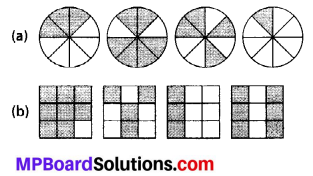
(c) Show \(\frac{2}{6}, \frac{4}{6}, \frac{8}{6}\) and \(\frac{6}{6}\) on the number line. Put appropriate signs between the fractions given.
![]()
Solution:
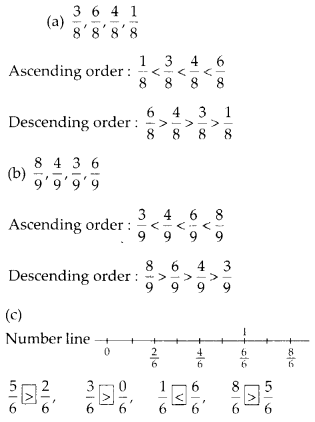
![]()
Question 2.
Compare the fractions and put an appropriate sign.
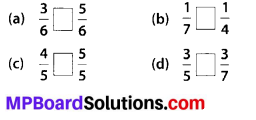
Solution:
(a)
\(\frac{3}{6}\) and \(\frac{5}{6}\) are like fractions.
Also, denominator of \(\frac{5}{6}\) is greater than denominator of \(\frac{3}{6}\)
![]()
(b)
\(\frac{1}{7}\) and \(\frac{1}{4}\) are unlike fractions with same numerator. Also, denominator of \(\frac{1}{7}\) is greater than denominator of \(\frac{1}{4}\)
![]()
(c)
\(\frac{4}{5}\) and \(\frac{5}{5}\) are like fractions.
Also, numerator of \(\frac{5}{5}\) is greater than numerator of \(\frac{4}{5}\)
![]()
(d) \(\frac{3}{5}\) and \(\frac{3}{7}\) are unlike fractions with same numerator. Also, denominator of \(\frac{3}{7}\) is greater than denominator of \(\frac{3}{5}\).
![]()
![]()
Question 3.
Make five more such pairs and put appropriate signs.
Solution:
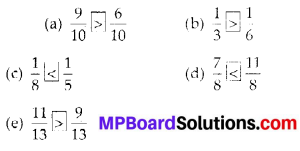
![]()
Question 4.
Look at the figures and write ‘<‘ or ‘>’, ‘=’ between the given pairs of fractions.
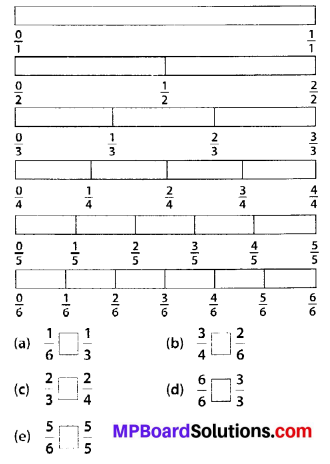
make five more such problems and solve them with your friends.
Solution:
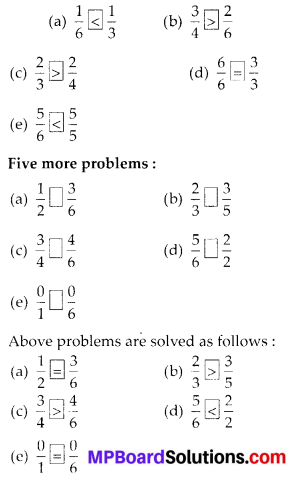
![]()
Question 5.
How quickly can you do this ? Fill appropriate sign (‘<‘, ‘=’, ‘>’)
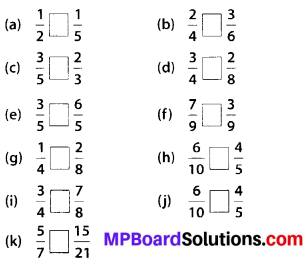
Solution:
(a) \(\frac{1}{2}\) and \(\frac{1}{5}\) are unlike fractions with same numerator. Also denominator of \(\frac{1}{5}\) is greater than denominator of \(\frac{1}{2}\).
![]()
(b) \(\frac{2}{3}\) and \(\frac{3}{6}\) are unlike fractions with different numerator.
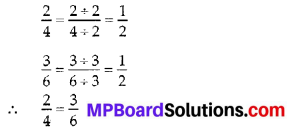
(c) \(\frac{3}{5}\) and \(\frac{2}{3}\) are unlike fractions with different numerator.
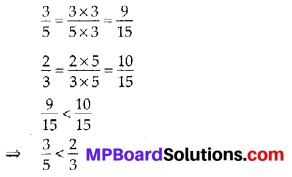
(d) \(\frac{3}{4}\) and \(\frac{2}{8}\) are unlike fractions with different numerators.
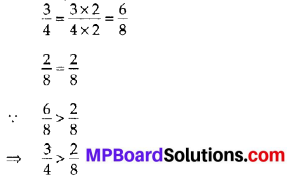
(e) \(\frac{3}{5}\) and \(\frac{6}{5}\) are like fractions. Also, numerator of \(\frac{6}{5}\) is greater than numerator of \(\frac{3}{9}\).
![]()
(f) \(\frac{7}{9}\) and \(\frac{3}{9}\) are like fractions. Also, numerator of \(\frac{7}{9}\) is greater than numerator of \(\frac{3}{9}\).
![]()
(g) \(\frac{1}{4}\) and \(\frac{1}{2}\) are unlike fractions with different numerators.
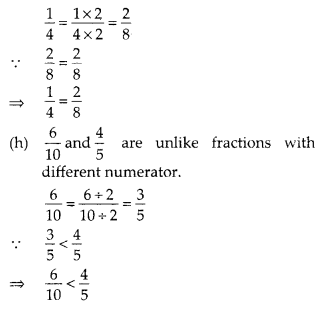
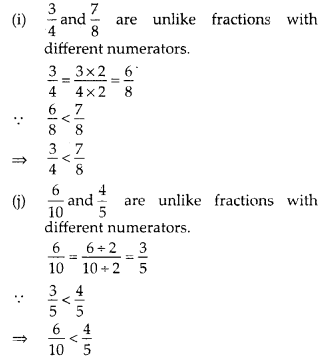
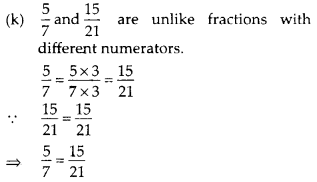
![]()
Question 6.
The following fractions represent just three different numbers. Separate them into three groups of equivalent fractions, by changing each one to its simplest form.

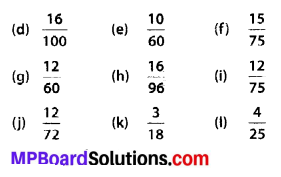
Solution:
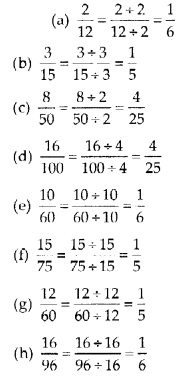
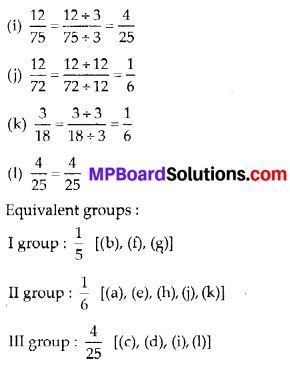
Question 7.
Find answers to the following. Write and indicate how you solved them.
![]()
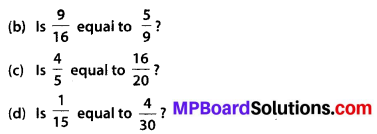
Solution:
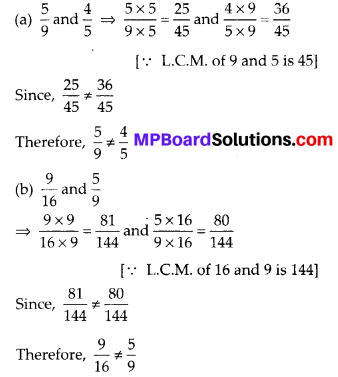
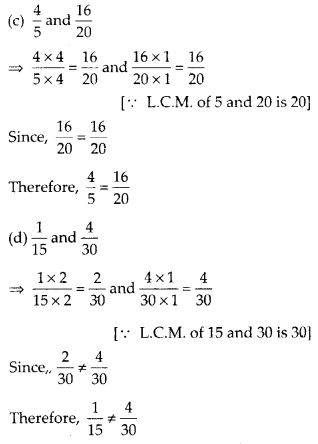
![]()
Question 8.
Ila read 25 pages of a book containing 100 pages. Lalita read \(\frac{2}{5}\) of the same book. Who read less ?
Solution:
Ila read 25 pages out of 100 pages.
Fraction of reading the pages
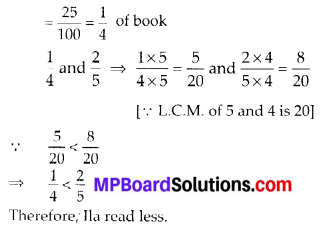
Question 9.
Rafiq \(\frac{3}{6}\) of an hour, while Rohit exercised for \(\frac{3}{4}\) of an hour. Who exercised for a longer time?
Solution:
Rafiq exercised \(\frac{3}{6}\) of an hour.
Rafiq exercised \(\frac{3}{4}\) of an hour.
Since, \(\frac{3}{4}>\frac{3}{6}\)
Therefore, Rohit exercised for a longer time.
![]()
Question 10.
In a Class A of 25 students, 20 passed in first class; in another class B of 30 students, 24 passed in first class. In which class was a greater fraction of students getting first class?
Solution:
In class A, 20 passed in first class out of 25.
∴ Fraction of first class passed students \(=\frac{20}{25}=\frac{4}{5}\)
In class B, 24 passed in first class out of 30.
∴ Fraction of first class passed students \(=\frac{24}{30}=\frac{4}{5}\)
Hence, both classes have same fraction of student getting first class.